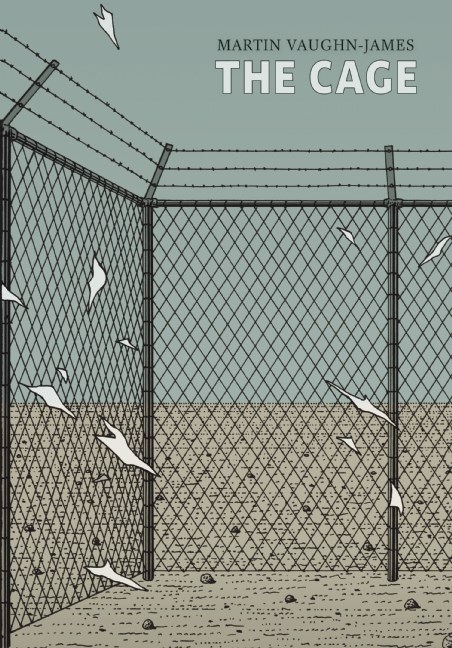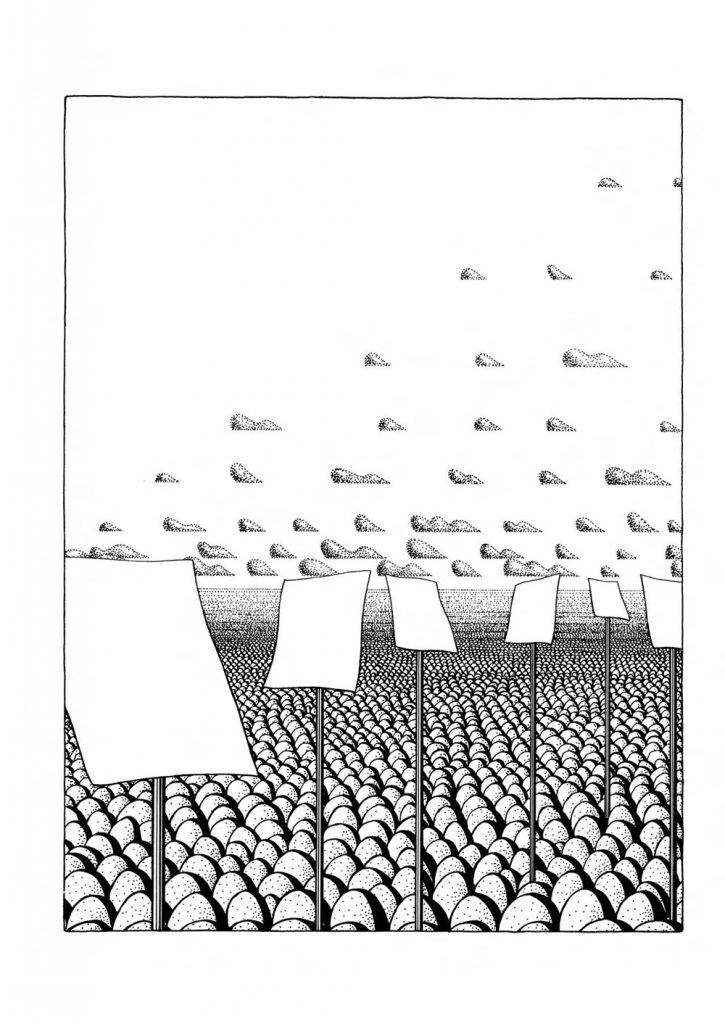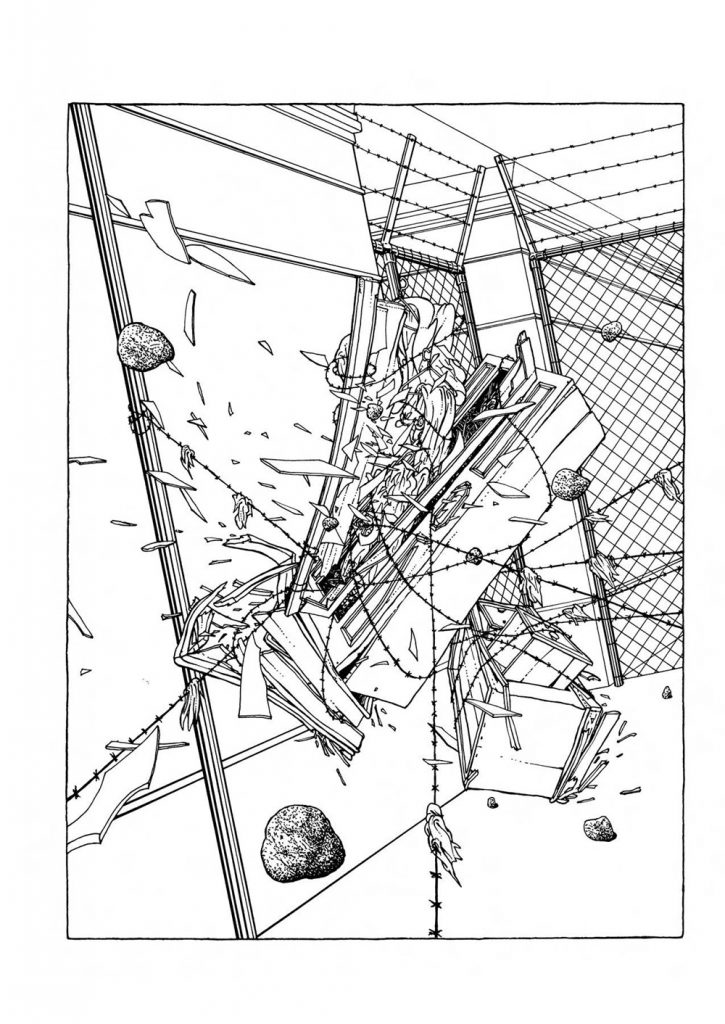Perhaps it would be easiest to begin with God. One of the many names of God, in Hebrew, is HaMakom: the Place. I’ve always liked this name because of what it implies: God is not simply a keeper in the Benthamite panopticon; God is the panopticon, keeping itself. God is not merely present; God is the very concept of presence. No matter the point in time and in space, it is not that God is there; it is that the point itself is God, and we are, all of us, with our bodies and our belongings, as small as a pen and as large as a ziggurat, traversing God, spatializing and temporalizing God, while also, in our own provisional and ephemeral ways, being God—traversing, spatializing, and temporalizing ourselves.
From the very beginning, we are taught to pay heed to category above all else: your proper human function is, more often than not, contingent on the limitations on your jurisdiction; go too big and you will be unmoored, incoherent, so know your limits. Even God cannot be properly defined without the relativist contrast with the earthly—indeed, God is viewed as the Creator, but a creator is only given credence by their creations—even the Almighty is constrained by the less-powerful. The Book of Genesis describes existence as an initially incoherent chaos until God approached the labor of categorical division (darkness, light; water, sky). In this way, by contrasting it, the constraint might be said to enforce the wide-open infinite—but who enforces the constraint?
Stepping into one of Yayoi Kusama’s Infinity Rooms is a form of ego death. Abstract shapes lovingly smother you; mirrored walls lit by overpowering saturated color allow you to see yourself—your selves, one would be tempted to say, kaleidoscopic as the space is—from an alien angle that flattens you into the space. You can’t look at yourself for long, not just because, at least in my experience, a custodian summarily beckons you to leave after thirty seconds but also because your self is the exact opposite of the point, which is to abolish the borders between internal and external. Kusama achieves this through constraint—the Infinity Room is a small space, not “cluttered” because of the sheer intent in its layout but still not leaving you much free room to navigate in; all you can do is walk the bare-minimum radius you are allotted, and, above all else, observe as you are projected onto this miniature world, which in turn projects its existence onto you: you allow yourself to melt into the universe, and allow the universe to melt into you. Thirty seconds feel like a short time, especially when you’re in there, but the more I think about it the more I wonder if one’s mind would not completely and entirely break by this disregard for border and boundary; if a larger, more concentrated dose of this infinity might not prove to be, to the Aristotelian-cum-Aquinian constraint-driven, category-obsessed mindset that has laid claim to our entire perception of reality, fatal.

Employing full-page panels (and the occasional double-page spread, but never more than one panel per page) and narration that reads like a mode of poetry in the grips of hypnosis (the opening line “the cage stands as before… unfinished and already decayed” sets the tone perfectly), Martin Vaughn-James’ The Cage achieves a stunningly-real depiction of an utterly-unreal state, detailing through space and time the onset of dilapidation of both matter and mind, in a world that appears to house no people at present but whose walls and structures, surrounded—suffocated—by desolate desert, certainly seem to echo a populated, glorious past. I am completely sure that I do not understand The Cage, and I am almost as sure that the book actively rejects understanding, at least on a literalist plane, but, nonetheless, I am fascinated by it, in part because the above is precisely what appears to preoccupy it: the failures of constraints against the infinite (be it framed in a religious-spiritual vocabulary or more secularly); the moment where the perceived truth of the structures of your reality has no choice but to reveal the limits of its usefulness, and all you are left with is an awe you cannot truly articulate.
The quality of Vaughn-James’ art and its resulting reality is precise, almost unbearably so; the world and landscapes are presented with a clinical, even-handed detachment, while also going back and forth in time, from moments in which the structures of the world were all clean and whole (yet already without a custodian) to the other end of the timeline, the one defined by entropy. Whatever the condition, the cartoonist is entirely devoted to its faithful depiction, whether the image is capable of being reproduced in real life or the impact of its representation relies on the constraints of fiction. This “nightmare realism” is most tangible in moments when not only are the containing structures (rooms, hallways) of the story advanced in their decay, but their contents, from furniture to technology to fabric to photographs, appear to almost explosively rebel, thrust into mid-air and contorting into shapes that they could not possibly take without living hands.
Vaughn-James’ back-and-forth is not limited to time but to space as well—the reader is led through rooms and hallways that do not appear to begin or end at any determined (or, indeed, determinable) point, and down exterior pathways in landscapes both urban and desert. We are shown pyramids and ziggurats, buildings and skyscrapers, and the various rooms of a vast house or station, as well as the titular wire-walled cage—all interrupting each other in utter refusal to make their identities, allegiances, and dynamics known. The narration itself refers to these landscapes as “the elaborate structure (of which the cage was merely one feature) / one facet of a complex network of forms arranged according to some logic / separate and alien to the surrounding desolation”—but we do not know where this structure ends and the desolation starts, and we do not know whether these forms exist in tandem in their literal depiction or whether they are, in fact, broken signifiers all meant to hint at the platonic glory of the whole.
Reading The Cage, I was reminded of another experimental comic on space and spatiality: the collection Outdoors by Yokoyama Yūichi. Yūichi is, in his works, completely uninterested in human emotions, in drama, wishing to create and inhabit a formal world detached of emotion. In the back of the collection, in an interview conducted by translator Ryan Holmberg, Yūichi says that he wants to draw people “as if they are being watched by insects or by animals or by the gods or by the room.” He succeeds, for the most part, too: his comics are dizzying, dominated by pure kinesis, of matter and of sound. His mission statement is clear, and, in its singular nature, admirable: insects, animals, gods, room—none of these wear shoes; but can you, dear reader, try to step into those shoes, nonetheless?

I was reminded, too, of a line of thought discussed in anthropologist Anna Lowenhaupt Tsing’s book on matsutake mushrooms, The Mushroom at the End of the World. The mushrooms, flourishing in environments of ruin and extensive human-industrial disruption, make, in the author’s mind, for a fascinating case study on “the possibility of life in capitalist ruins.” In the book, Tsing makes the case for the decentering of the human element in narrative, or the deprioritizing of what we consider the human point of view. It’s a hard idea to wrap our collective heads around, given that we are people doing people things and thinking people thoughts, but the fact of the matter is that we are only one part of the world, and that, though we disrupt and affect other facets and though they respond accordingly, there is still, and always will be, more to the world than just the human world; to think otherwise is solipsistic hubris. Popularity — or audience-minded art will, almost always, chase the familiar and the recognizable, emotionally, socially, and often geographically as well; the strange must come in moderation, dispensed with a steady hand. Having immersed oneself in the comforts of the recognizable, and having recognized that “recognizable” has become in fact synonymous with “satisfactory,” one might inquire about the dissatisfactory, being the totally alien (not just in contents but in mode of presentation and in structure, as well), raising the question: what does a story that not only doesn’t involve the human world but which does not engage itself in the human ways—that is entirely uninterested in the human perspective—even look like?
The quote from Yokoyama Yūichi and the narrative theory offered by Anna Lowenhaupt Tsing become particularly poignant when examining The Cage, but, while Yūichi’s stories are completely alienated, they are still contingent on human action, just detached of any interest in emotional understanding thereof; you still see life, even if the life is alienated. Removing the human from the equation, focusing on human absence—what does the room observe? In the completely neglected world of The Cage, the answer might be right in front of us: space is free to tell its own story, to retrace its own steps. In this story, space and time are characters—and life becomes a set-piece, optional but not crucial, present in its absence like a now-dead character whose significance is banished to dusty picture-frames. In a way, this is perhaps the most tangible manifestation of HaMakom: the Word is with God, and the Word is God, as the Place tells itself into existence.
While there is no evidence of a human present (which is to say, of a human presence), the world of The Cage certainly engages with a human past. Its structures (whether those in question are functional, like the houses and buildings, or in service of a larger structural system, like the monumental pyramids) are man-made, its furnishings (beds, chairs, tables, even the clothes displayed) made by and for humans, and even (perhaps especially) the sounds that occasionally make an appearance, preserved by recording devices—these are all indicative of human absence. I am not here to solve the narrative of The Cage, as “connecting the dots” in any literal fashion strikes me as counterproductive, but this does seem to bear an immense significance: there was life, and life gave way to stillness, and stillness now causes its surroundings to become something beyond stillness—to become anti-life, being decay. But, in the absence of life and the onset of decay, the decaying, too, comes alive: potted plants fill some of the hallways and rooms, though they were not there before; inanimate objects move around the space, sometimes moving in mid-air or tying themselves (or each other) up in cords, as if fighting some unknown war.
The recording devices and clothes that appear in the book are the clearest indicator of a past life, or of a representation of life, and perhaps the closest thing to “life” itself is a mass of black ink that appears to float around the spaces in the book, reminiscent less of a human being than of a poltergeist. At one stage in the non-linear book, a bottle of ink is shown to have tipped over, and the result, the reader can infer, is catastrophic—in its nightmare-logic the small amount of ink in the bottle not only comes alive but manages to increase itself, smearing itself over photographs, pooling across floors, floating through the rooms and hallways, reaching even the top of the pyramid; toward the end of the book, as the reader is taken on a tour through a decaying city, the sky is rendered as blank while its clouds are rendered the same way as the ink-stains, implying that this mass of ink, incapable of fulfilling its original function (given no writing hand to guide it), has broken out of its constraints and, in its way, overtaken the world, become totally and utterly free—and, in being so, has become totally and utterly alien, recognizable only through context.
This connection between function and constraint is one that is consistently addressed and enforced by the story itself. After all, even the titular cage—which is shown, parallel to the worshipful pyramids and the decaying house and buildings, neglected and falling apart—is nothing without its original function, which is constraint itself: thus function and constraint become synonymous, and freedom from one is freedom from the other. It then, both through the decay overtaking the structures and through the absence of human life, raises the question of what happens once these functions are rendered obsolete. One could see the answer as beginning, as it often does, with denial: with no one to employ its machines and devices, the machines and devices revert to the memory of their employment. When these memories prove to be insufficient, the machines and devices respond in the most human way possible—they lash out. The narration reflects this, too: it is at once confused and precise, collapsing in on itself yet attempting to evoke structural integrity. Read this way, the non-linear narrative going back to the days of well-kept glory might be the space’s coping mechanism, an attempt of “manifesting” through recollection.

Vaughn-James’ authorial voice recognizes, though, that this latching onto constraint is incoherent and futile, because there is no one to enforce these constraints, and, without an enforcer, they are doomed to fail: landscapes will collapse in on one another, their interiors embarking on wars in which they serve as both soldier as weapon. (The recovery of lost glories is somewhat inherently a fascistic principle, especially viewed through the lavish aesthetics of the marble paths leading to pyramids and of the palatial hallways we spend most of the book traveling through, but I would not venture to call The Cage an aesthetically fascist text precisely because of what it readily concedes and admits: entropy cares not about glory; it is an omnivorous force of equal opportunity, and it comes for everything in its time.)
“No live organism can continue to exist sanely under conditions of absolute reality,” wrote Shirley Jackson; “[r]ound the decay of that colossal Wreck, boundless and bare / The lone and level sands stretch far away,” wrote Percy Bysshe Shelley. “Look on my Works, ye Mighty, and despair!” commanded the latter’s Ozymandias, while the former’s narrator offered that “even larks and katydids are supposed, by some, to dream.” The lone and level sands depicted by Martin Vaughn-James’ The Cage, I think, are where Jackson and Shelley meet: where Ozymandias, like the larks and katydids, dreamed to escape the absolute reality, which is that pyramids, halls, skyscrapers—they all, in time, will fail, and no amount of preservation will afford one to claim otherwise. At the decay of constraints, and at the absence of their enforcers, only the infinite will survive; and the infinite, be they HaMakom or merely the place, will observe: unfinished and already decayed, the cages of our self-perception stand as before.
SOLRAD is made possible by the generous donations of readers like you. Support our Patreon campaign, or make a tax-deductible donation to our publisher, Fieldmouse Press, today.

Leave a Reply